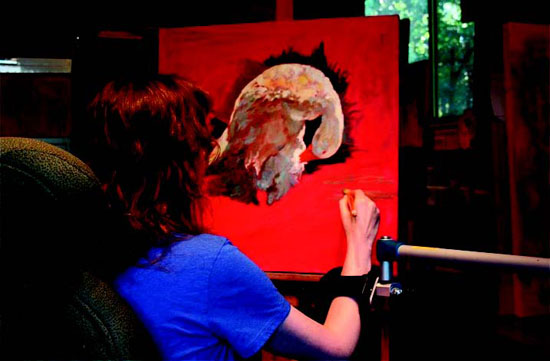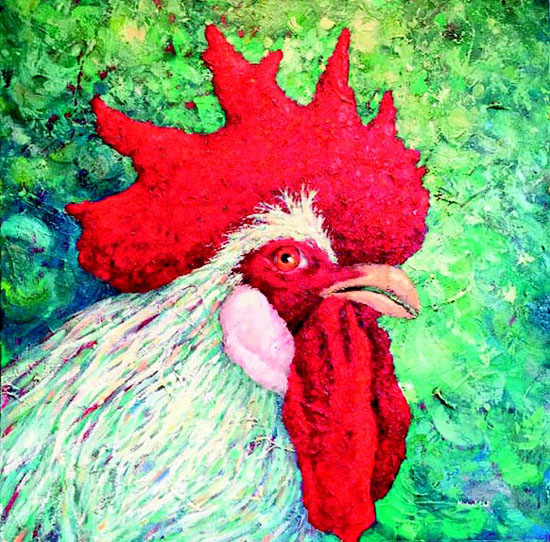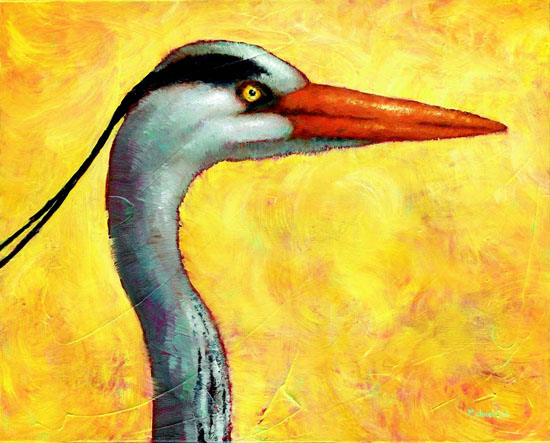 | | | Michael-Che Swisher uses a Saebo Mobile Arm Support to paint. Photos provided | | | | | | Eleven years ago artist and Moraga resident Michael-Che Swisher woke up with blurry vision. "Every time I moved my head I got nauseous," she says. "That happened for four months."
 A children's book illustrator, Swisher's vision got so bad that it began to interfere with her work. "It was the first time I was really late with a deadline," Swisher says. Not long after, she switched from illustrating to painting, a career move that accommodated for a less predictable work life. "I had to start over again and build up to getting into galleries. I did art shows for years, which was exhausting."
A children's book illustrator, Swisher's vision got so bad that it began to interfere with her work. "It was the first time I was really late with a deadline," Swisher says. Not long after, she switched from illustrating to painting, a career move that accommodated for a less predictable work life. "I had to start over again and build up to getting into galleries. I did art shows for years, which was exhausting."
 When she went to the hospital with split vision in 2004, medics told Swisher that there was a possibility of multiple sclerosis, a disease of the central nervous system that disrupts the flow of information within the brain and between the brain and body. "I didn't even know how to spell it," Swisher recalls. Her first fears surrounding MS were of losing her independence, being wheelchair bound or having to wear diapers. "It never occurred to me that I wouldn't be able to paint," Swisher says. "I'd never learned to do anything else."
When she went to the hospital with split vision in 2004, medics told Swisher that there was a possibility of multiple sclerosis, a disease of the central nervous system that disrupts the flow of information within the brain and between the brain and body. "I didn't even know how to spell it," Swisher recalls. Her first fears surrounding MS were of losing her independence, being wheelchair bound or having to wear diapers. "It never occurred to me that I wouldn't be able to paint," Swisher says. "I'd never learned to do anything else."
 Swisher was not given a diagnosis following her trip to the emergency room, but kept the possibility of MS in the back of her mind. Because she didn't have health insurance it was another nine years before she was officially diagnosed and fully realized what was happening to her body. By that time Swisher had already experienced blurred and split vision, balance issues, fatigue and difficulty with depth perception, all of which she had attributed to being tired.
Swisher was not given a diagnosis following her trip to the emergency room, but kept the possibility of MS in the back of her mind. Because she didn't have health insurance it was another nine years before she was officially diagnosed and fully realized what was happening to her body. By that time Swisher had already experienced blurred and split vision, balance issues, fatigue and difficulty with depth perception, all of which she had attributed to being tired.
 Two months after her diagnosis, Swisher suffered an exacerbation (a relapse caused by inflammation of the central nervous system) that affected her right arm.
Two months after her diagnosis, Swisher suffered an exacerbation (a relapse caused by inflammation of the central nervous system) that affected her right arm.
 "It got severely weak," Swisher says. "A twitch or tingle went down my whole arm and within five days it just hung there." Shortly thereafter, she lost her fine motor skills and had to learn to adapt to living with one arm. At the time she didn't know if she would ever paint again.
"It got severely weak," Swisher says. "A twitch or tingle went down my whole arm and within five days it just hung there." Shortly thereafter, she lost her fine motor skills and had to learn to adapt to living with one arm. At the time she didn't know if she would ever paint again.
 Originally from Western Maryland, Swisher came to San Francisco in 1995 to attend the Academy of Art University, formerly called the Academy of Art College. Of the schools she was considering, the Academy had the most drawing classes.
Originally from Western Maryland, Swisher came to San Francisco in 1995 to attend the Academy of Art University, formerly called the Academy of Art College. Of the schools she was considering, the Academy had the most drawing classes.
 Her artistic success is thanks to a combination of perseverance and talent. As a child, Swisher was enchanted by the boxes of paints and brushes that her mother, also an artist, kept in the storage room.
Her artistic success is thanks to a combination of perseverance and talent. As a child, Swisher was enchanted by the boxes of paints and brushes that her mother, also an artist, kept in the storage room.
 Though Swisher claims she had little natural talent, it is a bit hard to believe when you look at her work. She is represented by the Eisenhauer Gallery in Edgartown, Massachusetts, and the Nancy Dodds Gallery in Carmel, California, where you will find portraits of cows, bears, and an aviary of birds that range in personality from quirky to regal. Born out of her love for animals, Swisher's proliferation of creature creations led to an artistic pigeonholing that she likens to an actor being typecast. "People ask me if I don't know how to paint other things; and of course I do," Swisher says. Even so, she can't remember the last time she painted something other than an animal. "It's been years."
Though Swisher claims she had little natural talent, it is a bit hard to believe when you look at her work. She is represented by the Eisenhauer Gallery in Edgartown, Massachusetts, and the Nancy Dodds Gallery in Carmel, California, where you will find portraits of cows, bears, and an aviary of birds that range in personality from quirky to regal. Born out of her love for animals, Swisher's proliferation of creature creations led to an artistic pigeonholing that she likens to an actor being typecast. "People ask me if I don't know how to paint other things; and of course I do," Swisher says. Even so, she can't remember the last time she painted something other than an animal. "It's been years."
 A combination of therapy and persistence aided in Swisher's muscle recovery. "I never fully got back use of my [right] arm," she says. "I keep going backward and it takes me a really long time to recover." Though the relapses are emotionally difficult, she refuses to give up.
A combination of therapy and persistence aided in Swisher's muscle recovery. "I never fully got back use of my [right] arm," she says. "I keep going backward and it takes me a really long time to recover." Though the relapses are emotionally difficult, she refuses to give up.
 Swisher recently acquired a Saebo Mobile Arm Support, a zero gravity device that facilitates weak muscles during functional tasks. The Saebo holds Swisher's arm as she paints, prolonging her muscle endurance. She recalls seeing it in her studio for the first time. "It's not that I wasn't aware that I was disabled," Swisher says. "But when I walked in and [saw] it there, it was an emotional thing."
Swisher recently acquired a Saebo Mobile Arm Support, a zero gravity device that facilitates weak muscles during functional tasks. The Saebo holds Swisher's arm as she paints, prolonging her muscle endurance. She recalls seeing it in her studio for the first time. "It's not that I wasn't aware that I was disabled," Swisher says. "But when I walked in and [saw] it there, it was an emotional thing."
 But Swisher was quick to adapt, and now a year and a half later, the Saebo is just another part of her life. "It becomes normal so quickly," she says. "My muscles have gotten stronger [and] painting isn't as painful as when I originally started. Swisher is proud of the effort she's put into her recovery. "I was determined to continue doing this," she says. "You learn to adapt. I plan to try to always figure it out."
But Swisher was quick to adapt, and now a year and a half later, the Saebo is just another part of her life. "It becomes normal so quickly," she says. "My muscles have gotten stronger [and] painting isn't as painful as when I originally started. Swisher is proud of the effort she's put into her recovery. "I was determined to continue doing this," she says. "You learn to adapt. I plan to try to always figure it out."
 Swisher sees every new challenge as an obstacle to overcome. "The [brush] strokes themselves haven't really changed," she explains. "It just takes a while for my fine motor skills." When her 2013 exacerbation left Swisher unable to hold a brush, she painted with sponges and tried new techniques. Her engagement with her work is what draws Swisher back to the studio day after day.
Swisher sees every new challenge as an obstacle to overcome. "The [brush] strokes themselves haven't really changed," she explains. "It just takes a while for my fine motor skills." When her 2013 exacerbation left Swisher unable to hold a brush, she painted with sponges and tried new techniques. Her engagement with her work is what draws Swisher back to the studio day after day.
 "I like the challenge," Swisher says of trying new textures and working with unexpected tools. "I like the process of learning something new."
"I like the challenge," Swisher says of trying new textures and working with unexpected tools. "I like the process of learning something new."
 Swisher's painting is both the thrust for and the result of her incredible determination. "Sometimes I know what I paint is never going to go to a gallery," Swisher says, "but it inspires me, so I paint it anyway."
Swisher's painting is both the thrust for and the result of her incredible determination. "Sometimes I know what I paint is never going to go to a gallery," Swisher says, "but it inspires me, so I paint it anyway."

|


